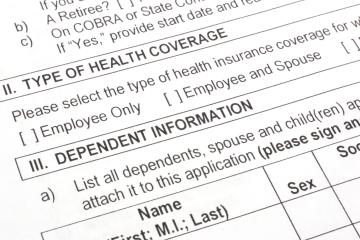
The effect of nudges on health insurance take-up in the United States

Resumen
In the United States, the health insurance system is particularly complex. Individuals who are not insured privately through their employers can either receive health insurance through a government program, such as Medicaid or Medicare (if they are eligible), or through the individual marketplace 1 for which premiums may be publicly subsidized.
Although uninsured rates have fallen in recent years, increasing health insurance coverage among people without insurance remains a policy priority. 2 In addition to helping avoid catastrophic health care expenses, access to insurance may lead to beneficial health outcomes, including a decrease in mortality, as demonstrated by a large-scale randomized evaluation of a set of reminders mailed to individuals who received a tax penalty for not having insurance the previous year [1].
Despite these benefits, enrolling in either the individual marketplace or Medicaid poses challenges for many individuals. In a 2021 survey of uninsured individuals who were eligible for coverage, roughly 20 percent reported that they found the enrollment process too difficult or confusing, 18 percent reported being unable to find a plan to meet their needs, and roughly 24 percent reported not needing or wanting insurance (survey participants could select multiple options). These responses show that a lack of information on how to apply for coverage or plan benefits and a lack of awareness of the benefits of health insurance may be key barriers to take-up. 2
Nudges—informational or behavioral strategies designed to inform individuals about various aspects of health insurance and influence actions without changing legal or economic systems—are one potential solution to address such barriers. These interventions can offer a cost-effective way to inform individuals of their eligibility, plan choices, and the benefits associated with insurance take-up.
A review of eleven randomized evaluations conducted between 2001 and 2019 that assessed the impact of various nudges aimed at increasing health insurance take-up among adults found these interventions to have a small but notable impact—both on encouraging individuals to take-up health insurance or to switch to plans with lower premiums and expected lower out-of-pocket costs to the individual. Across these studies, five different types of modalities were used, either alone or in combination. Low-intensity options included letters, postcards, emails, and application handouts and high-intensity options included phone calls. Acting as information sources, application guidance tools, and reminders, these nudges addressed barriers to health insurance take-up such as low salience, procrastination, lack of awareness of benefits, or choosing the wrong insurance plan. While including personalization may increase effectiveness, low-cost, mass outreach interventions can still lead to increased enrollment and plan switching.
Lecciones de la Evidencia
Studies analyzing take-up rates
| Study | Sample Size* & Study Population | Barriers Addressed | Strategy Used |
|---|---|---|---|
| Gordon et al., 2005 | 223 CHIP-eligible children, before ACA | Lack of awareness | Application hand-outs in the emergency room |
| Wright et al., 2017 | 159,898 potential Medicaid-eligible individuals | Procrastination, Complexity, Lack of salience of future benefits |
Postcards, emails, and phone calls that redesigned the state’s standard materials—simplified the description of the steps involved in enrollment, offered assistance, highlighted the urgency of completing the required steps in time to obtain coverage. |
| Domurat et al., 2021 | 87,394 individuals eligible for Marketplace coverage | Lack of awareness; Choice overload (hard to decide best plan choice) | Letters with information such as individualized subsidies and penalties, price comparisons among plans, quality comparisons among plans |
| Goldin et al., 2021 | 8,893,653 individuals eligible for Marketplace coverage and Individuals eligible for Medicaid | Lack of awareness, Misperception of consequences and plan benefits | Letters with individualized penalty information |
| Yokum et al., 2022 | 744,510 individuals eligible for Marketplace coverage | Lack of awareness, Cost, Complexity, Procrastination, Choice overload, and Inertia. | Letters with action language, an implementation intention prompt, a picture of then–chief executive officer of the marketplace, social norm messaging, a pledge, or loss aversion. |
| Ravel et al., 2022 | 2,173 individuals eligible for Marketplace coverage | Lack of awareness | Emails and phone calls |
| Myerson et al., 2022 | 79,522 individuals eligible for Marketplace coverage | Lack of awareness, low health insurance literacy or computer literacy, preference for in-language assistance, and choice overload | Phone calls |
| Ericson et al., 2023 | 58,238 individuals eligible for Marketplace coverage | Procrastination, forgetting, Misperceptions of plan cost | Letters with generic and personalized information.** |
Studies analyzing plan switching rates
| Study | Sample Size* & Study Population | Barriers Addressed | Strategy Used |
|---|---|---|---|
| Kling et al., 2012 | 451 individuals with prescription plans under Medicare Part D | Comparison Friction (the gap between the availability of information about different options and the consumer’s use of it to make comparisons) |
Letters which included personalized price information created by entering consumer’s prescription use data into Medicare's Plan Finder website. While this information is publically available and widely advertised, these nudges went the additional step of providing the information |
| Ericson et al., 2017 | 15,534 individuals with Marketplace coverage | Inertia | Letters and emails which provided consumers who would be re-enrolled in their current plans with personalized information about the savings if they switched plans |
| Feher and Menashe, 2019 | 19,159 individuals with Marketplace coverage | Choice error | Emails and postcards for consumers who were eligible for plans with lower out-of-pocket costs and higher value were sent information regarding potential choice errors. |
*One key advantage of studies on low-cost nudges is their generally large sample size (the median sample size across the eleven studies in this publication is roughly 58,000), which allows for more reliable analyses of impacts across different subsets of the population.
**This study also looked at the impact of a simplified, “check-the-box” enrollment, which is outside the scope of this insight.
Nudges targeting a large array of barriers to uninsured populations increased health insurance take-up.
Interventions tested across eight randomized evaluations [1] [2] [3] [4] [5] [6] [7] [8] targeted a range of barriers to take-up, including lack of awareness or forgetfulness, complexity, low salience of costs and benefits, choice overload, procrastination, and preference for assistance in languages other than English. The interventions reviewed were generally able to reduce such barriers for populations eligible for Medicaid and those eligible for subsidized plans on the individual marketplace. Most interventions increased enrollment within the range of 0.3 to 14.8 percentage points, with an average impact of 5.1 percentage points and a median impact of 2.3 percentage points.
Nudges can be particularly effective at encouraging take-up among low-income populations.
Three studies [3] [4] [7] found that low-income individuals were more likely to enroll in health insurance or remain insured after the intervention than higher-income populations. In California, letters that made subsidy and plan comparison information more accessible [4] and personalized phone calls [7] increased enrollment among low-income individuals compared to higher-income individuals. In a national study [1] researchers observed larger effects of the intervention on the take-up of insurance among individuals whose household income fell below the Medicaid threshold across all states and a larger effect in states that expanded Medicaid than in those that did not.
Further, one study [4] found that for households with higher incomes (above 250 percent of the federal poverty level), providing subsidy information was counterproductive relative to basic reminders. Individuals with low subsidies may misunderstand or undervalue the benefits of insurance in a way that reduces take-up. Including information about these benefits may be needed to overcome this misperception.
Nudges are also generally effective in encouraging switching among consumers who already have insurance but are not enrolled in the lowest-premium plan.
Barriers to switching include comparison friction, or the gap between the availability of information about different options and the consumer’s use of it to make comparisons, and choice error, particularly choosing a higher-cost plan when one is eligible for a lower-cost option that has similar or better insurance properties. To reduce potential choice error, consumers who were eligible for plans with higher subsidies but were enrolled in other plans were sent information regarding the higher-subsidy plans [9]. This information increased plan switching by 2 to 4 percentage points, for email-only and mail-plus-email interventions respectively (an 11 to 22 percent increase from a baseline of 18 percent). Letter recipients saved, on average, roughly $65 per year. Plan switchers saved, on average, $84 per month in premiums, or over $1000 annually, and $56 per month in reduced out-of-pocket expenses, or over $670 annually.
In the context of comparison frictions in prescription-drug insurance, researchers sent personalized price information created by entering individuals’ prescription use data into Medicare's Plan Finder website. While this information was publicly available and widely advertised, the additional step of providing the information had an impact on plan switching, increasing switching by 11 percentage points (a 65 percent increase from a baseline of 17 percent) [10]. Letter recipients saved, on average, $100 per year. Plan switchers saved, on average, roughly $365 per year.
However, a study showing no impacts raises questions on the effectiveness of nudges on inertia, in which consumers are reluctant to change plans after market offerings change and they might benefit from switching [11]. In this study, researchers provided consumers who would be re-enrolled in their current individual marketplace plans with personalized information about the savings on insurance premiums that they could realize from switching plans and encouraged them to shop for new plans. While this intervention increased shopping on the marketplace, it had no impact on consumers switching to lower-cost plans. Notably, this study did not include the lowest income, and therefore potentially most cost-sensitive, population. Because defaults are another common behavioral intervention, this finding indicates that more research on the effectiveness of defaulting individuals into their plans is needed, as well as a better understanding of whether individuals are intentionally choosing higher-cost plans.
For both health insurance take-up and plan switching, nudges—particularly low-intensity, non-personalized efforts—are cost-effective.
Low-intensity efforts such as letters and emails cost an average of $0.78, with costs of the intervention ranging from $0 for emails to $0.55 to $1.75 for letters [1] [3] [4] [5] [8] [9]. The average cost per member enrolled for low-intensity interventions was approximately $60.48, ranging from $0 for emails to $12 to $191 for letters. More-intensive interventions (i.e. personalized phone call outreach), ranged in cost from about $4 [7] to $28 [3]. The cost per member enrolled for more intensive interventions averaged around $207.
Because the marketplace receives a percentage of premiums from insurance companies, each member enrolled through the marketplace also leads to increased revenue for the marketplace. One study [7] calculated that the intervention had a two-to-one return on investment, making this intervention potentially profitable for state-wide marketplaces.
Including a personalized component within the nudges may increase their effectiveness.
Of the studies reviewed, eight out of eleven [1] [3] [4] [6] [7] [8] [10] [11] incorporated a personalized component ranging from a personalized estimate of a penalty, personalized subsidy or after-subsidy premium cost, personalized enrollment assistance, one-on-one phone conversation, guidance on plan selection, and case management.
Two studies [7] [10] evaluated the effects of personalized interventions compared to a control group, while six studies [1] [3] [4] [6] [8] [11] included comparisons on the effects of non-personalized nudges to personalized ones. Additional personalized information included personalized telephone outreach [3] [6] or information on estimated subsidy, penalty, and monthly premium [1] [4] [8] [11].
Three of the six studies that incorporated a personalized component indicated that customized information, such as the inclusion of personalized penalty or subsidy estimates or the addition of personalized phone calls, increased enrollment compared to a generic letter [1] [6] [8]. The other three studies did not show a clear impact of personalized components on enrollment or switching rates [3] [4] [11]
While including personalization may increase effectiveness, the positive impact of non-personalized interventions, such as handing out Medicaid/CHIP applications in the emergency department [2] or targeting a specific population but not personalizing on an individual level [9], demonstrates that low-intensity interventions can still lead to increased enrollment and plan switching.
In addition, one study found that action language (such as “You’re almost done”) was more effective than generic messaging for individuals that started the process of enrolling [5].
While most nudges had a positive effect on enrollment and plan switching, the impact was often small. Given the potential of increased health care coverage to lead to beneficial health outcomes, more research is needed to understand what mechanisms can further increase take-up and switching.
Nudges can reduce some—but not all—barriers to enrollment for individuals who can afford coverage. It should also be noted that nudge-based interventions also do not address the barriers for millions of individuals in the United States who cannot afford insurance on the Marketplace and may not be eligible for Medicaid.
More research is needed on the impact of other, non-nudge interventions. For instance, comprehensive case management,3 where the counselors not only inform the consumers and provide information but help push the applications through the Medicaid office, could be more effective for populations facing the most barriers to take-up or selecting the lowest-cost plans. Simplified enrollment, such as “check the box” mechanisms [8], and automatic enrollment,4 where individuals must take an action to unenroll (rather than taking an action to enroll), may also be highly effective in certain settings at increasing enrollment by not requiring individuals to overcome common barriers to health insurance enrollment. Finally, more research on structural changes, such as increasing plan options, efforts to increase healthy behaviors, and impacts of insurance on health care utilization and health outcomes, continue to be needed.
Abdul Latif Jameel Poverty Action Lab (J-PAL). 2023. "The effect of nudges on health insurance take-up in the United States" J-PAL Policy Insights. Last modified April 2023.
“Marketplace-Glossary.” Healthcare.gov. Accessed on April 6, 2023. https://www.healthcare.gov/glossary/marketplace
Tolbert, Jennifer, Patrick Drake, and Anthony Damico. 2022. “Key Facts about the Uninsured Population.” Last modified December 12, 2022. https://www.kff.org/uninsured/issue-brief/key-facts-about-the-uninsured-population/
Flores, Glenn, Milagros Abreu, Christine E. Chaisson, Alan Meyers, Ramesh C. Sachdeva, Harriet Fernandez, Patricia Francisco, Beatriz Diaz, Ana Milena Diaz, and Iris Santos-Guerrero. 2005. “A Randomized, Controlled Trial of the Effectiveness of Community-Based Case Management in Insuring Uninsured Latino Children.” Pediatrics 116, no. 6 (December):1433–41. DOI: 10.1542/peds.2005-0786.
Shepard, Mark, and Myles Wagner. 2022. NBER Working Paper. “Reducing Ordeals through Automatic Enrollment: Evidence from a Subsidized Health Insurance Exchange”. NBER Working Paper no. 30781. https://www.nber.org/papers/w30781
Goldin, Jacob, Ithai Z. Lurie, and Janet McCubbin. 2021. “Health Insurance and Mortality: Experimental Evidence from Taxpayer Outreach.” The Quarterly Journal of Economics 136, no. 1 (February): 1–49. DOI: 10.1093/qje/qjaa029
Research Paper
Gordon, James A., Jennifer A. Emond, and Calrso A. Camargo, Jr. 2005. “The State Children's Health Insurance Program: a Multicenter Trial of Outreach through the Emergency Department.” American Journal of Public Health 95, no. 2 (February): 250–253. DOI: 10.2105/AJPH.2003.037242
Research Paper
Wright, Bill J., Ginny Garcia-Alexander, Margarette A. Weller and Katherine C Baicker. 2017. “Low-Cost Behavioral Nudges Increase Medicaid Take-Up Among Eligible Residents Of Oregon.” Health Affairs 36, no. 5: 838–845. DOI: 10.1377/hlthaff.2016.1325
Research Paper | J-PAL Evaluation Summary
Domurat, Richard, Isaac Menashe, and Wesley Yin. 2021. "The Role of Behavioral Frictions in Health Insurance Marketplace Enrollment and Risk: Evidence from a Field Experiment." American Economic Review 111 no. 5 : 1549-74. DOI: 10.1257/aer.20190823
Research Paper | J-PAL Evaluation Summary
Yokum, David, Daniel J. Hopkins, Andrew Feher, Elana Safran, and Joshua Peck. 2022. Effectiveness of Behaviorally Informed Letters on Health Insurance Marketplace Enrollment: A Randomized Clinical Trial. JAMA Health Forum 3, no. 3. DOI:10.1001/jamahealthforum.2022.0034
Research Paper
Ravel, Katie, Jahan Ahrary, Karen Avakian, Andrew Feher, and Isaac Menashe. 2022. Effect of Personalized Outreach on Medicaid to Marketplace Coverage Transitions: A Randomized Clinical Trial. JAMA Health Forum 3, no. 10 DOI: 10.1001/jamahealthforum.2022.3616
Research Paper
Myerson, Rebecca, Nicholas Tilipman, Andrew Feher, Honglin Li, Wesley Yin, and Isaac Menashe. 2022. “Personalized Telephone Outreach Increased Health Insurance Take-Up For Hard-To-Reach Populations, But Challenges Remain.” Health Affairs 41, no. 1 (2022): 129–13. DOI: 10.1377/hlthaff.2021.01000
Research Paper
Ericson, Keith M. Marzilli, Timothy Layton, Adrianna McIntyre, and Adam Sacarny. 2023. “Reducing Administrative Barriers Increases Take-up of Subsidized Health Insurance Coverage: Evidence from a Field Experiment.” NBER Working Paper No. 30885.
Research Paper | J-PAL Evaluation Summary
Feher, Andrew, and Isaac Menashe. 2021. “Using Email and Letters to Reduce Choice Errors Among ACA Marketplace Enrollees.” Health Affairs 40, no. 5: 812–819. DOI: 10.1377/hlthaff.2020.02099
Research Paper
Kling, Jeffrey R., Sendhil Mullainathan, Eldar Shafir, Lee C. Vermeulen, and Marian V. Wrobel. 2012. "Comparison Friction: Experimental Evidence from Medicare Drug Plans." The Quarterly Journal of Economics 127, no. 1 (February): 199–235. https://doi.org/10.1093/qje/qjr055
Research Paper | J-PAL Evaluation Summary
Ericson, Keith M. Marzilli, Jon Kingsdale, Timothy Layton, and Adam Sacarny. 2017. “Nudging leads consumers in Colorado to shop but not switch ACA Marketplace plans.” Health Affairs 36, no. 2 : 311–319. DOI: 10.1377/hlthaff.2016.0993
Research Paper | J-PAL Evaluation Summary

